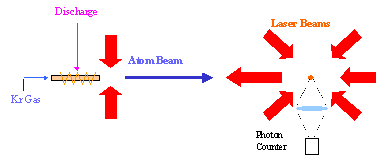Atom Trap, Krypton-81, and Saharan Water
X. Du,1 K. Bailey,1 Z. El Alfy,2
B. El-Kaliouby,3 B. E. Lehmann,4 R. Lorenzo,4
Z.-T. Lu,1 P. Mueller,1 T. P. O'Connor,1 R.
Purtschert,4 N. C. Sturchio,5 M. Sultan,6 L.
Young7
1Physics Division, Argonne National
Laboratory; 2Egyptian
Geological Survey and Mining Authority, Cairo, Egypt; 3Geology
Department, Ain Shams University, Cairo, Egypt; 4Physics
Institute, University of Bern, Switzerland; 5Department
of Earth and Environmental Sciences, University of Illinois at Chicago;
6Geology Department, State
University of New York, Buffalo; 7Chemistry
Division, Argonne National Laboratory
Motivation
We are developing the Atom Trap Trace Analysis (ATTA) method for the trace analysis of two long-lived krypton isotopes, 81Kr (t1/2 = 2.3x105 years, isotopic abundance ~ 10-13) and 85Kr (t1/2 = 10.8 years, isotopic abundance ~ 10-12).81Kr is a cosmogenic isotope produced in the upper atmosphere. Its analysis allows age determination for
| 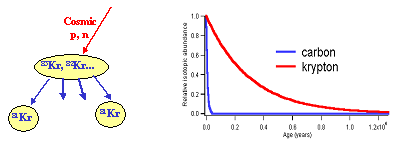 |
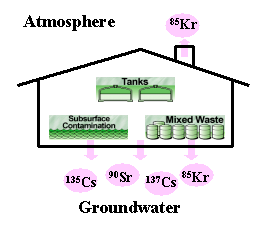 | 85Kr is an anthropogenic isotope produced through fission of uranium and plutonium. Its analysis in the atmosphere can help in verifying compliance with the Nuclear Non-Proliferation Treaty by monitoring nuclear fuel re-processing activities as well as detecting leaks from fuel containers for nuclear safety issues. |
Method
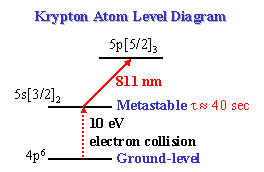 | |
In ATTA, atoms of the desired isotope are selectively captured into a magneto-optical trap (MOT) and detected by observing the fluorescence of the trapped atoms. This detection scheme is so sensitive, that a single atom can be easily discerned when captured in the MOT. The required isotopic selectivity comes from the isotope shift of the trapping transition at 811 nm. Each isotope is trapped only when the laser is precisely tuned to its respective transition frequency. This allows for the background free detection of the extremely rare isotopes 81Kr and 85Kr in a sample of natural krypton gas. 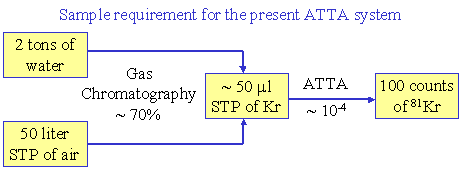 The overall counting efficiency determines the required sample size and is a key system parameter. At present, we have completed the development of a second-generation ATTA machine with a counting efficiency of 1x10-4. | 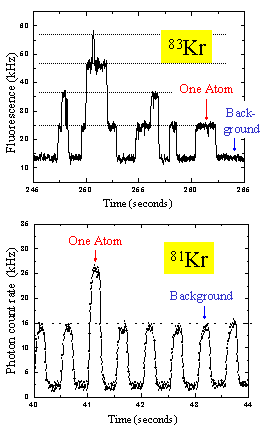 |
Results
| We have determined the ages of groundwater at six sites, ranging from 200,000 to 1,000,000 years, in the Nubian Aquifer underneath the Eastern Sahara Desert. These results revealed hydrologic behavior of this huge aquifer, with important implications for climate history and water resource management in the region. With this demonstration, widespread application of 81Kr in Earth sciences now appears feasible. | 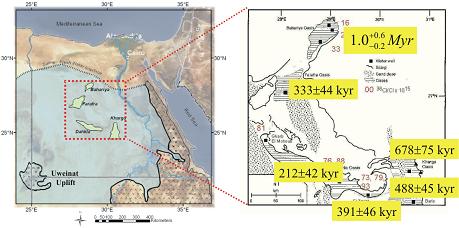 |
This work is supported by NSF, Division of Earth Sciences, under Award No. EAR-0651161, and by DOE, Office of Nuclear Physics, under Contract No. DE-AC02-06CH11357.
Selected publications
One million year old groundwater in the Sahara revealed by krypton-81 and chlorine-36 GRL Abstract / Preprint (physics/0402092)N. C. Sturchio, X. Du, R. Purtschert, B. E. Lehmann, M. Sultan, L. J. Patterson, Z.-T. Lu, P. Mueller, K. Bailey, T. P. O'Connor, L. Young, R. Lorenzo, B. M. Kennedy, M. van Soest, Z. El Alfy, B. El Kaliouby, Y. Dawood, and A. M. A. Abdallah
Geophysical Research Letters 31(5), L05503 (2004)
Geophysical Research Letters 31(5), L05503 (2004)
A new method of measuring 81Kr and 85Kr abundances in environmental samples GRL Abstract / Preprint (physics/0311118)
X. Du, R. Purtschert, K. Bailey, B. E. Lehmann, R. Lorenzo, Z.-T. Lu, P. Mueller, T. P. O'Connor, N.C. Sturchio, and L. Young
Geophysical Research Letters 30, 2068 (2003)
Geophysical Research Letters 30, 2068 (2003)
Ultrasensitive isotope trace analyses with a magneto-optical trap
C.Y. Chen, Y.M. Li, K. Bailey, T.P. O'Connor, L. Young, Z.-T. Lu
Science 286, 1139 (1999)
Science 286, 1139 (1999)
![[Argonne Logo]](/images/argonne_header_logo.jpg)
![[DOE Logo]](/images/header_doe.gif)
